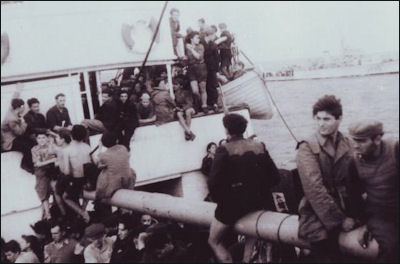EARLY TENSIONS AND FIGHTING BETWEEN JEWS AND ARABS IN PALESTINE

Jewish immigrants to Palestine During the British colonial period in Palestine (present-day Israel and the Palestinian near-states in the West Bank and Gaza Strip) Jewish terrorist movements were active in Palestine and Arab terrorist movements were active in Aden. They were motivated by nationalist rather than religious aims They attacked military and administrative targets with the goal of convincing their colonial enemy that it wasn’t worth the cost in blood to stick around. The tactic sort of worked but took time: the British left Israel after World War II but didn’t leave Aden until 1963.
In the early 1920s, Arabs clashed with Jews claiming that Palestine could only support 600,000 people and there was not enough room for the new Jewish immigrants. The policy shaped by Churchill during this period called for modified Zionism with a homeland for the Jews and a homeland for other people. Muslims declared jihad against the Jews
Iz al-Din al-Qassam (Izzadin Al Kassem) was an Islamic preacher who led rebels against the Jews and the British in the 1930s. He was killed by British forces in a village near Jenin. Israelis regard him as the father of Palestinian terrorism. Palestinians regard him as a martyr and as a George Washington-like hero. The military wing of Hamas and some home-made missiles are named after him.
The famous British general Bernard (“Monty”) Montgomery did a stint in Palestine in 1930. Commenting on the violence he witnessed, he wrote, “The Jew kills the Arab and the Arab kills the Jew. This is what happens now in Palestine and this will probably happen for the next 50 years.” A commission that studied the problem concluded that tolerance was “a quality which today is almost unknown.”
Riots in the 1920s and 1930s
There were violent clashes between Arabs and Jews in Palestine in 1920, 1921, 1929, 1936 and 1939. In 1929, following a religious dispute at the Wailing Wall in Jerusalem and declaration by a Muslim leader that Jews plan to take over al-Aqsa Mosque, riots erupted across Palestine. A total of 133 Jews and 116 Arabs were killed.
Illegal immigrants to Israel In the 1929 riots, Palestinian Arabs killed 67 Jews and injured 60 in sectarian violence in Hebron. Afterwards that the 600 Jews that lived there fled and there were no Jewish families left Hebron. Thirty-two families returned briefly two years later but they were evacuated by the British.
In 1936, another serious outbreak of violence occurred after waves of Jewish immigrants arrived in the wake of Hitler’s persecution of the Jews in Germany and the Mufti of Jerusalem called for a suppression of Jewish immigrations. Jews and Arabs fought against each other and the British.
The Jewish scholar Gershom Scholem wrote in August 1936: “For the past thee months, we in Jerusalem have been living under siege. There’s a considerable amount of terrorism...A few days ago a colleague of mine who teaches Arabic literature was murdered in his study while reading the Bible. No one knows whether someone will toss a bomb his way or around the next corner.” In June 1939 he wrote: “We live in terror” and described the capitulation of the English in “the face of violence.”
Jewish Militants in Palestine

King David Hotel bombing Jewish militants opposed to the British blockade and detention of immigrants responded by blowing up bridges, railways and bridges. Two famous Israeli terrorist-freedom-fighters, Meir Feinstein and Moshe Barazani, blew themselves up with a hand grenade smuggled to them in prison in an orange rather than allow themselves to be hanged as terrorists. [Source: Joseph Judge, National Geographic, April 1983 [♦]
Lehi, Etzel and the Haganah, commonly known as the Stern Gang and the Irgun, were Jewish militias and underground militant groups that tried to overthrow the British mandate in Palestine. Their members included future Prime Minister Menachim Begin. The terrorist tactics they used were not all that different from those used by militant Palestinian groups in their struggle against Israel. The Haganah, led by Ben Gurion and supported by the majority of Israelis, developed into the modern Israeli defense forces.
Begin once said, “It is the Hebrew which will decide the boundaries of the Hebrew State.” On July 22, 1946, the Irgun gang blew up the west wing of the King David Hotel, killing 91 people, most of them members of the British forces. In 1948, another future prime minister of Israel, Yitzak Rabin, ordered his men to open fire on fellow Jews on the ship Altalena that were bringing arms to Jewish paramilitary groups headed by Begin.
Massacre of Arabs by Jews in Deir Yasin

Irgun logo Jewish militants also carried out terrorist activities against Arabs. At four o'clock in the morning on April 9, 1948, 132 Jewish terrorists from the Irgun and Stern Gang, led by Begin, attacked the peaceful, sleeping Arab villages of Deir Yasin, west of Jerusalem. When they left eight hours later between 100 and 250 men, women and children had been killed and 15 houses were dynamited. Some of the women were butchered with knives. Others were shot with their children. The corpses were piled and burned in a nearby quarry.
The event scared Palestinians and played a role in the fleeing of Palestinians from Israel when it declared independence a month later. Many Palestinians feared what happened in Deir Yasin might happen to them. Begin later wrote in his memoirs, “Arabs throughout the country, induced to believe wild tales of “Irgun butchery,” were seized with limitless panic and started to flee for their lives...The political and economic significance of this development can hardly be overestimated.”
There were also a number of brutal attacks by Arabs against Jews. After World War II, Jerusalem was under a siege with the Arabs getting food supplies from neighboring Arab countries while the Jews were cut off from the supplies from the coast. Some Jews resorted to eating weeds to stay alive.
Arab-Jewish War in 1948
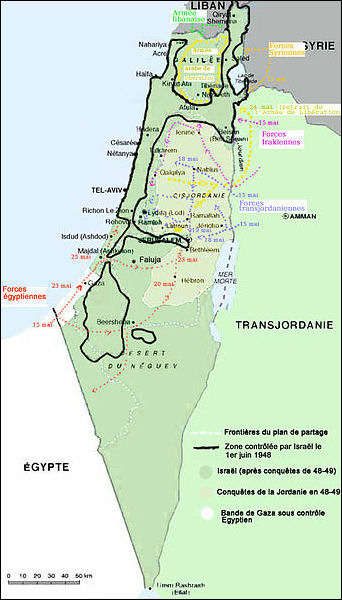
Israel, 1948 Within five hours after Israel proclaimed its independence it was attacked all at once by six Arab states — Egypt, Jordan and Lebanon and smaller forces from Saudi Arabia, Syria, and Iraq — and Arab militias within Palestine, who openly declared their desire to destroy the Jews. This war is generally known as the 1948 Arab-Israeli War but Israelis call it the War of Independence. Israel lost 6,000 people — about one percent of its population and more than it lost in other wars — but not only held off the Arabs it gained territory in the exchange. Thousands of Arabs were also killed.
One Israeli who was at seven at the time of the attack told the Los Angeles Times he was sitting down for a feast at his kibbutz near Syria to celebrate independence when he got the news that war had started. “Suddenly, the guards came in and said, “The Syrians are coming down from the hills.” Everyone ran out of the dining room. We could see the Syrians convoys and the tanks coming down from the Golan, and it was clear there was going to be a war.”
Recalling the fighting near his kibbutz near Syria, the settler interviewed by the Los Angeles Times said, “We were told to gather on the road near the Jordan River. I remember crawling under bombardment. I remember bullets whizzed by and bombs exploded nearby.” He said he was evacuated from the area in trucks carrying the wounded.”
Israel launched an offensive against Egyptian positions on southern coast in what is now the Gaza Strip and against Arab communities south of Jerusalem. They captured the high ground and shelled villages. Egyptian soldiers pulled back and told Palestinians villagers to flee, saying they would regroup and counterattack. The counterattacks never came.
There were examples of massacres and indiscriminate killing of Arab civilians by Israeli forces and accusations that they committed ethnic cleansing. Many Arabs were driven from their homes.
Fighting in Jerusalem in the Arab-Jewish War in 1948
Jordan’s Arab Legion, trained and led by British officers, distinguished themselves by holding on to East Jerusalem and the West Bank and capturing the heights of Jerusalem and the Old City and incorporated them into Jordan. Lt. Abdullah Salam was a Jordanian officer that took part in the battle to reclaim Jerusalem. When he first arrived in the Old City he was so overwhelmed to be in the sacred city of Islam he got out of his car to kiss the ground. He was dead before his head reached it.♦
Israeli heavy artillery used in the battle for Jerusalem consisted of 2-pounder cannons and home-made 6-inch mortars called Davidkes.” During the fighting supplies were brought to Israeli fighters in the Old City and the wounded were carried out in a coffin-size metal boxes that was pulled on a cable strung 160 feet high across the valley between the Old City and Mt. Zion.
The Arabs fled from the southern suburbs but held on to the Old City and the Eastern hills. The Jews kept West Jerusalem. Eighty Israeli commandos tried to hold the Jewish Quarter in the Old City and its 2,000 Jewish residents but they were no match for the Arabs and ultimately had to surrender. The Jews were kicked out of the Old City.
End of the Arab-Jewish War in 1948 and Changes After It
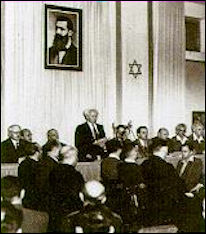
Declaration of Israel, 1948 The Israelis won the Arab-Jewish War in 1948. Separate armistices were signed with different Arab nations in 1949. The borders that were defined effectively became Israel’s borders until the Six-Day War in 1967. Ralph Bunche became their first African-American to win a Nobel prize after he was awarded the Peace Prize in 1949 for his efforts as a U.N. diplomat to end the Arab-Jewish War.
The Arab-Jewish War left Israel in kind of a suspended animation for the next 20 years, vulnerable to attacks and raids from its Arab neighbors. The situation was not resolved and Israel’s security was not achieved until the Six-Day War in 1967. The failure of five Arab nations to stop a half million Jews was a humiliation that was hard to live down.
The 1948 war ended with Israel claiming much of the land allocated to it under the United Nations plan. Nearly all of the territory assigned to the Palestinian Arabs — the West Bank, East Jerusalem but not the Gaza Strip — was annexed by Transjordan. With this accomplished, King Abdullah changed the name of Transjordan to Jordan.
After the 1948 war, Israel declared Jerusalem its capital. Even today most countries don't recognize this claim and keep their embassies in Tel Aviv. The only portions of Palestine that remained under Arab control were the West Bank, occupied by Jordan, and the Gaza Strip occupied by Egypt. Neither Jordan or Egypt granted Palestine autonomy. Jordan ended up annexing the West Bank.
After the war the Israeli government immediately began building infrastructure to secure the territory under its control. The Israelis argued they were only doing this for security reasons. The Arabs saw it as an annexation of Palestinian and Arab land and accused Israel of having no plan to return it and no plan to resettle the Palestinian refugees. None of the Arab countries had any diplomatic contact with Israel. Most refused to talk to Israel under any circumstances.
Fate of Arabs and Palestinians After the Arab-Jewish War in 1948

Arab volunteers During and after the Arab-Jewish War around 600,000 to 700,000 Arabs fled their homes and were forced to move to refugee camps in other countries or under Israeli control. The Israelis claim that no more than 250,000 were forced to flee. The Palestinians claim there more than 1 million were.
One refugee, who fled a village southwest of Jerusalem, told the Los Angeles Times, “I swore I would not leave my village until I saw them coming in with my own eyes, but the shelling was too much. We were forced to leave.” He said he fled southwest towards the Hebron Hills. In May 1949, he settled into a refugee camp established by the Red Cross in the Jordanian-controlled West Bank.
About 500,000 to 600,000 Arab refugees fled to Jordan and the Jordanian-controlled West Bank. Denied a homeland West Bank Palestinians, reluctantly, united with Jordan .Many Palestinians also ended up in the Egypt-controlled Gaza Strip. In the meantime Israel opened its borders to any Jew anywhere in world. Immigration caused it population to soar.
For all intents and purposes, the Arabs that lived in the West Bank, Gaza Strip or fled their homes in Israel became Palestinians and those that remained in Israel became Israeli Arabs. The Palestinian refugees endured confusion, hunger, suffocating heat in the summer and cold and rain in the winter. Many stayed in tents until the mid 1950s when they moved into cinder-block structures and subsisted on rations donated by the Red Cross.
Israeli Seizure of Palestinian Land and Homes

Menachim Begin The Israelis captured land occupied by Arabs and Palestinians. According to Israeli myth, the Palestinians fled because their leaders promised them they could return to their land when Israel was destroyed. When the Israeli arrived the land was empty and they felt it was within their right to take over the land. This was true in some cases but not all cases. In many cases, the Palestinians left because they feared for their lives and feared that if they they returned they would be killed. Fresh in their minds was the massacre of innocent Arabs by Deir Yassin by Israeli militants. Some Arabs were expelled from the land by Israeli soldiers, had the houses destroyed and were even killed. One Jewish settler told the Los Angeles Times, “They didn’t want us, and there was only one choice: It was either us or them.”
In 1948, Israelis began seizing Arab land. Arab villages and homes were taken over or destroyed by Israeli militias who terrorized Palestinians. At the same time laws were passed that directly or indirectly prevented Arabs from raising new buildings or expanding their farms. The laws also limited their access to education, social benefits and jobs.
The Israelis demolished Palestinian homes in East Jerusalem and other parts of Israel. One woman fainted at the sight of her house being razed. The excuse given for the demolition was that the houses had been built without permits. [Source: Tad Szulc, National Geographic June 1992 [♥]
One Palestinian resident of East Jerusalem told National Geographic, "The original owners of this land left for America in 1930, and that's when my family settled here. Jordan law said that if you cultivate the land and live and work on it for 30 years, then you are entitled to half of it if the original owners return." When Israel captured East Jerusalem from Jordan in 1967, Jordanian law no longer applied. In the case of the Palestinian in East Jerusalem his claim was rejected in an Israeli court, and he was evicted and his house was bulldozed down.
In some cases Jewish Israelis moved into homes formally occupied by Palestinians. One Palestinian man who revisited his home in Israel, which was taken over by a Kurdish Jew told the Los Angeles Times, “he has my life, And he is here instead of me.”
These days few Palestinians hold onto to any hope that they will gave their homes or land returned. The United Nations 1967 Security Council Resolution 242 calls for the total withdrawal from all occupied land in return for total security.
Desire for a Palestinian Homeland and Attacks on Arabs

Fatah, Nasser meeting Many Palestinian militants regard establishing a homeland for the Palestinian as one of the primary aims of their struggle. Some Palestinians regard Jerusalem as their home even though they have never laid eyes on the place. Even those who were born abroad, schooled abroad and have careers abroad ask "When do we go home?"
Many Israelis are not sympathetic. They point out that many Jews lost homes in Germany, Poland, Iraq and other places. In response to a question about a homeland for the Arabs an Israeli merchant, "Look, these Arabs have 21 state. We only have one. Where would I go?" [Source: Priit J. Vesiland, National Geographic, July 1985 [*]
In the 1950s, Israeli retaliations and reprisals were often way out of proportion to the original Arab acts that triggered the retaliations. As a reprisal for the murder of an Israeli woman and her two children in 1953, the Israelis blew up 40 Arab houses in the West Bank village of Qibya, killing 69 Arabs. Ariel Sharon had a hand in the raid. He later said he thought the houses were empty. On October 29, 1956, Israeli troops killed 43 Arab civilians near the central Israeli town of Kfar Kasm for breaking a curfew. In one Israeli raid in the Egyptian-controlled Gaza Strip, which had been unprovoked, 39 Egyptians were killed and more than 100 were injured. A State Department report called the killings the worst “butchery” since the 1949 armistice.
Discrimination Against Arabs and Palestinians
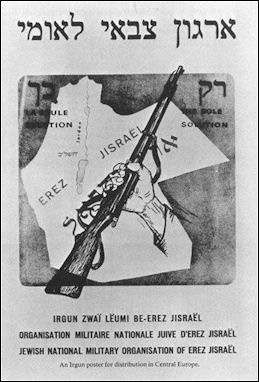
Irgun poster Arab Israelis are supposed to have the same rights as Jewish Israelis. They complain they are prevented from entering pubs and restaurant and get mean stares when they speak Arabic on the streets. They also note that less money flows into Arab jurisdictions than Jewish ones; few Arabs hold high level political offices; their separate school system is inferior; and that they don’t have access to as good of medical care as other Israelis.
Arab citizens are denied many employment opportunities. They are barred from many high level public jobs and hold less than 6 percent of civil service jobs. They are often relegated to menial jobs. Arab Israelis are prevented from buying homes in Jewish neighborhoods and kept from building new homes or expanding their exist homes. They have difficulty getting landlords who will rent to them and find that if they do move into a Jewish area they get dirty looks from their neighbors. Sharon endorsed “Jews only” land legislation which could allow Jews to bar Arab citizens of Israel from living or purchasing homes in many Israeli communities.”
In a poll taken in the late 1990s, 60 percent of Israelis said they would not rent an apartment to an Arab, while 40 percent said they would not rent to a homosexual, 33 percent to an ultra-Orthodox Jew and 25 percent to a Russian immigrant.
Israeli Arabs have complained that they have been followed by children, who chanted, “Go to Jordan, go to Egypt, go to Iraq — this is not your country — and adults shout, “Death to Arabs.” Racism against Arabs is particularly high among conservatives and ultra-Orthodox Jews. Some conservatives have floated the idea of rounding up Arab citizens are forcing them to live in another country or region. One Arab politician told the Washington Post, “I have never once felt like a real Israeli.”
Six-Day War

Six Day War On May 19, 1967, after months of high tension between Israel and Egypt, Egyptian President Gamal Abdel Nasser demanded that United Nations forces withdraw from the Gaza Strip and Sinai peninsula. To almost everyone’s surprise, the United Nations forces left. Nasser then moved Egyptian troops across the Sinai to the border of Israel, signed a military pact with Jordan and established a blockade on the Gulf of Aqaba on the Red Sea, Israel's outlet to the Eastern half of the world, and closed it to Israeli shipping.
Fearing an imminent strike by the Arabs, Israel launched a preemptive strike on June 5, 1967, thrusting into the Sinai, destroying nearly the entire Egyptian Air Force, and soon afterwards engaging Jordanian and Syrian forces. In six swift days Israeli forces swept west to the Suez Canal, East to the Jordan River, and north over the Golan Heights.
Israel defeated Egypt, Jordan and Syria and captured the Sinai and the Gaza Strip from Egypt; East Jerusalem and the West Bank from Jordan; and the Golan Heights from Syria. For years Syria had used the Golan Heights to rain shells on northern Israel.
Book: “Six Days of War” by Michael B. Oren (Oxford University Press 2002) is regarded as an excellent book.
Background for the Six-Day War

Air Attack on Jerusalem Nasser had been condemning Israel and giving rebel-rousing speeches about freeing Palestine for years although he admitted privately that Israel was militarily superior. His speeches however stirred up calls for action by Arabs and accusations that he was “hiding” behind United Nations troops. His declaration against Israel were about machismo and saving face as much as anything. His army was not prepared for a war with Israel.
Israel on the other hand was ready. When Israeli Foreign Minister Abba Eban visited the United States before the war he said that Israeli forces has superior training, motivation and communications and could defeat the Arabs on three fronts in less than two weeks if they were allowed to shoot first. Many Israeli citizens were fearful that they were going to be annihilated. Some dug trenches in their backyard and parks were prepared to serve as cemeteries.
Israel had been armed by the United States. Syria and Egypt were armed by the Soviet Union. The prime minister of Israel was Ben-Gurion’s successor, Levi Eshkol. There was a lot of tension in Israel at the time and many people wondered if Eshkol was up for the job. The famous one-eyed Israeli defense minister Moshe Dayan played a major part in the war, displaying reserve, courage and “MacArthur-like insubordination.” Ariel Sharon led the ground offensive in the Sinai.
End of the Six-Day War and Afterwards
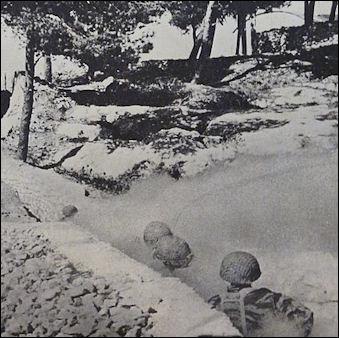
Ammunition Hill The Six-Day War ended on June 11 with a United-Nations-brokered cease-fire signed by representatives of Israel and Syria. By July, United Nations forces were patrolling cease-fire lines set up along the Syrian-Israeli frontier and the Suez Canal.
The United Nations rejected a Soviet-sponsored resolution that condemned Israel and called for restoring the 1949 armistice. Negotiations between the leaders of the Soviet Union and the United States failed to make any progress to solve the matter. United Nations demands that Jerusalem be partitioned were rejected by Israel. Indar Jit Rikhye, an Indian general with the United Nations, said, “I think you’re going to have a major Middle East war and I think we will still be sorting it out 50 years from now.”
After the Six-Day War, Israel occupied the West Bank and East Jerusalem (previously held by Jordan), the Gaza Strip and Sinai (previously held by Egypt) and the Golan Heights (previously held by Syria) and claimed all of Jerusalem. It denounced the armistice agreement of 1949, which had established Israel’s borders, and declared it was going to hold on to conquered territory, including Jerusalem. Jews who viewed the West Bank as a gift of God to the Jewish people were happy. Others felt the land should be traded for peace. The Golan Heights were annexed Israel in 1981.
Israel called for direct Arab-Israeli talks to restore peace and settle differences. The Arab nation reject the offer and continued to not recognize Israel as a state. Some have suggested that the conflict was a “calculated war of conquest” by Israel. Historians have largely discredited this theory. At that time of the war Dayan and others worried aloud about the burdens and unpleasantries that comes with occupation. Israel continues to occupy the Golan Heights. The Sinai was given back to the Egyptians as part of the Camp David Peace Accord in 1978. The West Bank and the Gaza Strip were handed over to the Palestinians after the Oslo Peace Accord in 1993.
Palestinians and Arab Nations After the Six-Day War

Six Day War
Battle of Golan Heights About 1.2 million Palestinians lived in the territories that came under Israeli occupation after the Six-Day War. Many Palestinian refugees fled to Jordan, Syria and Lebanon from the new Israeli-occupied territories. Those that remained in the West Bank and Gaza Strip lived under Israeli occupation. Palestinians who were out of the country when the war broke out lost their residency status and could not return. Some were unable to visit their families for more than 30 years.
The Israeli government began building settlements on occupied Palestinian land not long after the war ended. In 1968, Israel annexed about 800 acres of the Arab sector surrounding Jerusalem and 30 acres in the former Jewish quarter of Arab Jerusalem. Israel continued to occupy Arab land while peace negotiations were carried out.
Arabs refer to the defeat as the “Humiliation of 1967.” The Egyptians, who started the war to avenge earlier humiliations, put in a particularly dismal performance. Many Arabs blamed the defeat, not on Israel's military skill, but on a lack of faith in Islam, and was an early impetus behind launching the movement toward a militant, political Islam.
The Soviet Union and its allies stepped up their military and economic aid to Egypt, Syria and other Arab countries. All the Eastern bloc countries, with the exception of Romania, broke off diplomatic relations with Israel. Only King Hussein of Jordan turned down Communist aid and sought support from the West.
Clashes between Israeli forces and Jordanian and forced occurred along the cease-fire lines late in 1967 and in 1968. On August 21, 1969, an Australian Christian religious fanatic set fire to the Al Aksa Mosque in Jerusalem, causing sever damage and sparking riots. He said he “did it to make Jesus come back” and said that could not happen until non-Christian s had been cleared from the Temple Mount.
Tensions between Palestinians and Israelis increased when Israel declared that the entire city of Jerusalem, including annexed East Jerusalem, was the capital of Israel in 1980 and announced plans to build Jewish settlements in the Israeli-occupied West Bank in 1982.
Image Sources: Wikimedia Commons
Text Sources: New York Times, Washington Post, Los Angeles Times, Times of London, The Guardian, National Geographic, The New Yorker, Time, Newsweek, Reuters, AP, AFP, Wall Street Journal, The Atlantic Monthly, The Economist, Global Viewpoint (Christian Science Monitor), Foreign Policy, Wikipedia, BBC, CNN, NBC News, Fox News and various books and other publications.
Last updated July 2012

